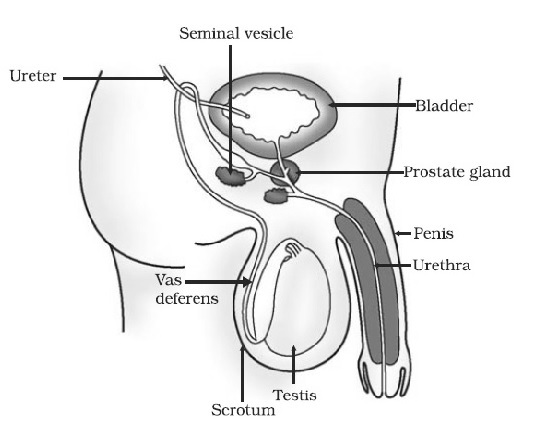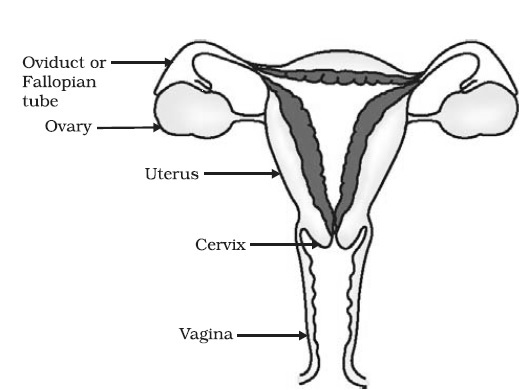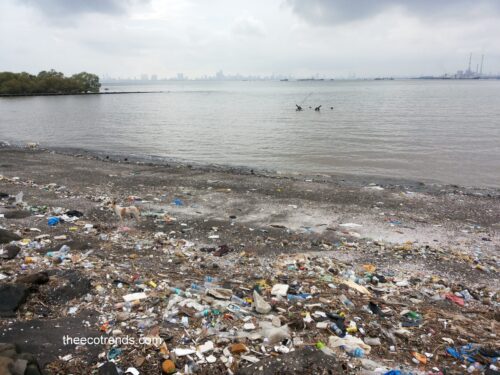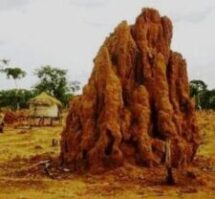In human beings reproduction takes place through the activities of male and female reproductive organs. To understand this, it is essential to study the structure of male and female reproductive systems separately.

The details of the male reproductive system and its different organs are given below –
(i) Testes: In human body a pair of testes ate found that remain enclosed inside a bladder like muscular structure called scrotal sac. The scrotal sac is found outside the main body situates under the penis. Cells of testes produce sperms.
Normally it is not possible to produce sperms on body temperature. The temperature required for the production of sperms should be 2 to 3 Celsius degrees less than the body temperature. This is why the scrotal sac remains outside the body.
Some cells of testes secrete male reproductive hormone called as testosterone. In males this hormone is secreted from 15 to 18 years of age. Due to impact of this hormone male reproductive organs develop and sperms start developing in the testes. The secondary sexual characters like development of hairs on face and around sex organs, and changes in voice etc.
Every testis is connected to Epididymis which stores sperms developed inside it. The length of a single sperm is 1/100 part of an mm. It has head, middle piece and a tail. The middle part has many mitochondria.
(ii) Epididymis: It is a long and coiled tubule which is attached to the posterior part of the testes.It contains sperms. It finally ends up in a tube which is called as vas difference.
(iii) Vas difference: It is a muscular thin tube with contractile wall which encircles the urinary bladder and finally opens into ureter.
(iv)Seminal vesicle: It is a structure made of many small tubules. It is variously coiled. It secretes seminal fluid which is called as semen after it gets mixed with sperms. Semen is white coloured dense and semi liquid substance with specific smell.
(v) Prostategland: It is a double lobed gland. Its tubules open in the urinary passage. It secretes an alkaline substance which is called as prostrate fluid. It mixes with semen and neutralizes the acidity of female’s vagina.
(vi) Cowper’s gland: Just below the prostate gland there is another gland which is found in pair. This gland is called as Cowper’s gland. It is connected to urinary tract through a small passage. It secretes a white alkaline liquid which is smooth and acts like a lubricant.
(vii) Penis: This is external reproductive organ of a male. It contains urinary duct which is common for urine and semen. There are three rows of spongy tissue along the urinary duct. The rows provide hardness to the penis when filled with blood. The anterior part of the penis is a swollen oval structure called as glans. It is covered with double layers of skin which is called as prepuse.
Female Reproductive System

Female reproductive system in human female is more complex than human male reproductive system. The reason behind it is that the female reproduction system has many works to do for example development of ova, reception of sperms, providing nutrition to zygote, and development of embryo. In order to complete all these functions female reproductive system comprises following parts –ovary, Fallopian tube, uterus, vagina, and vulva. The details are as below –
(1) Ovary:
In human females two ovular structures are found that are called as ovary. These are located in left and right of the main body of female reproductive system.
Ovary has following two functions –
(i) Production of ova, and
(ii) Secretion of female hormone like estrogen and progesterone.
Every ovary alternatively produces one ovum and sends the same to the uterus. The development of ova and secretion of female sex hormones start at the age of 10 to 11 years. No sooner than the secretion of female sex hormones starts the development of internal and external sex organs starts in human female. It is his time that secondary sexual characters like development of mammary glands, growth of hairs, broadening of cervics etc. starts.
(2) Oviduct or Fallopian Tube
A funnel shaped structure starts from each ovary which is connected to uterus. This is called as oviduct or fallopian tube. The oviduct forms a structure of finger like projections near ovary which is called as
Fimbri.
After each 28 days every ovary releases an ovum alternatively which is caught by Fimbri and transferred to oviduct. The oviduct has two principal functions-
(i) Transfer of ova to uterus, and
(ii) Providing space for fertilization.
(3) Uterus
It is a muscular triangular organ which is located in the pelvic cavity. It is generally 7.5 cm in length, 5 cm in breadth, and 3.5 cm in thickness. It broad part is found upside with oviducts emerging out from the left and right side. The lower conical part of uterus is called as neck which contains a small pore in the middle through which only sperms can enter into the uterus.
Three principal functions of uterus are-
(i) Conduction of menstruation cycle,
(ii) Bearing fetus and providing nutrition to it, and
(iii) Causing growth and development of the embryo.
(4) Vagina
It is a long and muscular tube. Its length depends on the length of the female. It is extended from external genitalia to the neck of the uterus. Its internal wall is made of epithelium which contains small glands that secrete slimy and smooth liquid. Vagina contains a thin membrane called as Hymen which is found in pre- teenager girls. It is removed to physical activities like running, jumping or due to the starting of menstruation.
Vagina has four functions-
(i) It provides passage to male’s penis,
(ii) It leads the semen to uterus,
(iii) It provides path to the internal secretions to come out, and
(iv) It extends in size to let the infant come out.
(5) External Genitalia or Vulva
Vagina opens through an external aperture called as vaginal opening. There is another opening above the vaginal opening which is the opening for urinary excretion. The muscular part around these is called as external genitalia. The bulging triangular part of the external genitalia is called as pubis and the hair growing on this area are called as pubic hair.
There are three parts of the external genitalia-
(i) Labia Majora
(ii) Labia Minor, and
(iii) Clitoris
Images- NCERT
Key words; male and female reproductive system




